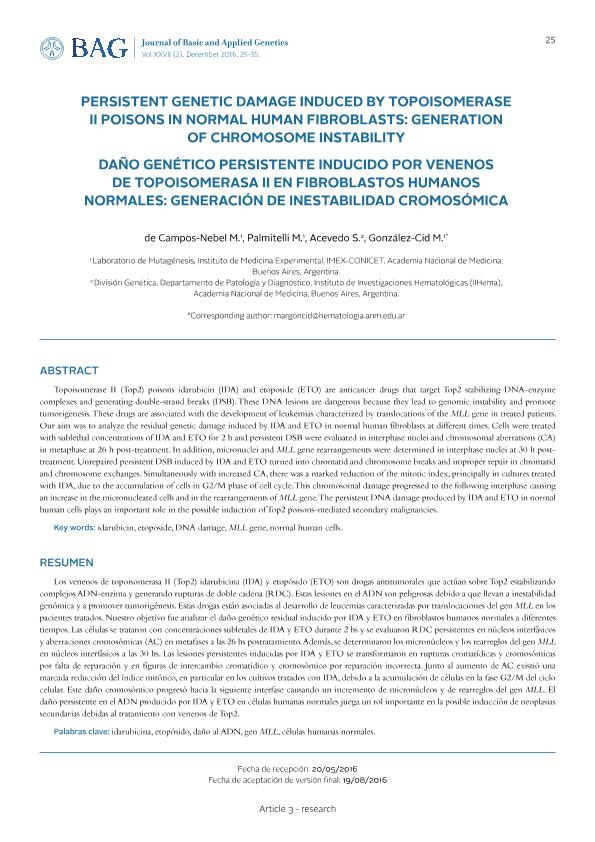Artículo
Topoisomerase II (Top2) poisons idarubicin (IDA) and etoposide (ETO) are anticancer drugs that target Top2 stabilizing DNA-enzymecomplexes and generating double-strand breaks (DSB). These DNA lesions are dangerous because they lead to genomic instability and promotetumorigenesis. These drugs are associated with the development of leukemias characterized by translocations of the MLL gene in treated patients.Our aim was to analyze the residual genetic damage induced by IDA and ETO in normal human fibroblasts at different times. Cells were treatedwith sublethal concentrations of IDA and ETO for 2 h and persistent DSB were evaluated in interphase nuclei and chromosomal aberrations (CA)in metaphase at 26 h post-treatment. In addition, micronuclei and MLL gene rearrangements were determined in interphase nuclei at 30 h posttreatment.Unrepaired persistent DSB induced by IDA and ETO turned into chromatid and chromosome breaks and improper repair in chromatidand chromosome exchanges. Simultaneously with increased CA, there was a marked reduction of the mitotic index, principally in cultures treatedwith IDA, due to the accumulation of cells in G2/M phase of cell cycle. This chromosomal damage progressed to the following interphase causingan increase in the micronucleated cells and in the rearrangements of MLL gene. The persistent DNA damage produced by IDA and ETO in normalhuman cells plays an important role in the possible induction of Top2 poisons-mediated secondary malignancies. Topoisomerase II (Top2) poisons idarubicin (IDA) and etoposide (ETO) are anticancer drugs that target Top2 stabilizing DNA-enzyme complexes and generating double-strand breaks (DSB). These DNA lesions are dangerous because they lead to genomic instability and promote tumorigenesis. These drugs are associated with the development of leukemias characterized by translocations of the MLL gene in treated patients. Our aim was to analyze the residual genetic damage induced by IDA and ETO in normal human fibroblasts at different times. Cells were treated with sublethal concentrations of IDA and ETO for 2 h and persistent DSB were evaluated in interphase nuclei and chromosomal aberrations (CA) in metaphase at 26 h post-treatment. In addition, micronuclei and MLL gene rearrangements were determined in interphase nuclei at 30 h posttreatment. Unrepaired persistent DSB induced by IDA and ETO turned into chromatid and chromosome breaks and improper repair in chromatid and chromosome exchanges. Simultaneously with increased CA, there was a marked reduction of the mitotic index, principally in cultures treated with IDA, due to the accumulation of cells in G2/M phase of cell cycle. This chromosomal damage progressed to the following interphase causing an increase in the micronucleated cells and in the rearrangements of MLL gene. The persistent DNA damage produced by IDA and ETO in normal human cells plays an important role in the possible induction of Top2 poisons-mediated secondary malignancies.
Daño genético persistente inducido por venenos de topoisomerasa II en fibroblastos humanos normales: generación de inestabilidad cromosómica
Título:
Persistent genetic damage induced by topoisomerase II poisons in normal human fibroblasts: generation of chromoso me instability
de Campos Nebel, Ildefonso Marcelo ; Palmitelli, Micaela; Acevedo, S.; Gonzalez Cid, Marcela Beatriz
; Palmitelli, Micaela; Acevedo, S.; Gonzalez Cid, Marcela Beatriz
 ; Palmitelli, Micaela; Acevedo, S.; Gonzalez Cid, Marcela Beatriz
; Palmitelli, Micaela; Acevedo, S.; Gonzalez Cid, Marcela Beatriz
Fecha de publicación:
12/2016
Editorial:
Sociedad Argentina de Genética
Revista:
Basic and Applied Genetics
ISSN:
1666-0390
Idioma:
Español
Tipo de recurso:
Artículo publicado
Clasificación temática:
Resumen
Palabras clave:
Idarubicina
,
Etoposido
,
Daño al Adn
,
Gen Mll
,
Idarubicin
,
Ectoposide
,
Dna Damage
,
Mll Gene
Archivos asociados
Licencia
Identificadores
Colecciones
Articulos(IMEX)
Articulos de INST.DE MEDICINA EXPERIMENTAL
Articulos de INST.DE MEDICINA EXPERIMENTAL
Citación
de Campos Nebel, Ildefonso Marcelo; Palmitelli, Micaela; Acevedo, S.; Gonzalez Cid, Marcela Beatriz; Daño genético persistente inducido por venenos de topoisomerasa II en fibroblastos humanos normales: generación de inestabilidad cromosómica; Sociedad Argentina de Genética; Basic and Applied Genetics; XXVII; 2; 12-2016; 25-35
Compartir



